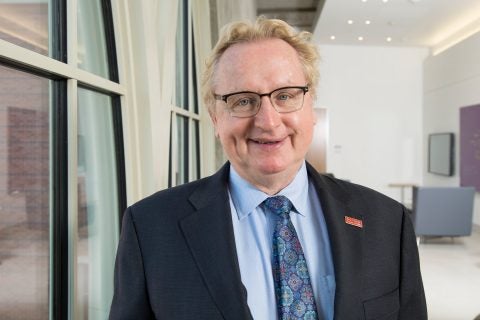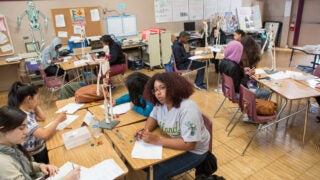Scientists aim to catalyze USC drug discovery using workshops and new technology
Scientists at USC Dornsife and the USC Michelson Center for Convergent Bioscience are hoping to spark drug research across the university by hosting a series of workshops starting Friday.
- How can scientists speed up drug discovery?
Vsevolod “Seva” Katritch believes that new advanced technologies and collaborations between biologists, chemists, pharmacologists and computational scientists like himself are the key to hitting the accelerator. He envisions a moment in the not-too-distant future when scientists will shorten the time it takes to discover the best potential treatments and begin clinical trials.
This shared vision is why Katritch and Charles McKenna, both from the USC Dornsife College of Letters, Arts and Sciences, founded the Center for New Technologies in Drug Discovery and Development (CNT3D) at their college last summer.
The CNT3D, also supported by the USC Michelson Center for Convergent Bioscience, MESH Academy and Bridge Institute, will host its first “Drug Discovery Innovation Workshop” on Friday, Feb. 24.
The workshop will draw experienced drug hunters — scientists developing new drug discovery technologies — as well as researchers who have been curious but never attempted it. Together, they will discuss new ways to expand and accelerate drug discovery efforts across USC.
The typical timetable for most potential drugs is daunting and the effort arduous. On average, it takes about 15 years and about $3 billion to discover, test and deliver a drug for the U.S. Food and Drug Administration’s approval, according to a JAMA study published in March 2020.
Katritch hopes the workshop will be a source of inspiration for researchers who thought they could never get an idea for a drug therapy off the ground. To help them, Katritch and his lab have developed V-SYNTHES, a computational method for rapid screening of billions of potential molecules to select a few potential drug candidates for treating a condition or disease.
Those candidates predicted by V-SYNTHES can be quickly and reliably synthesized and tested experimentally to identify the best compounds.
“V-SYNTHES applications already are bringing the first encouraging lead molecules to our collaborators at the Keck School of Medicine of USC who are working on new therapies for Alzheimer’s disease and cancer,” said Katritch, a computational biologist and chemist at USC Dornsife and the Bridge Institute.
Drug Discovery Innovation Workshop: Likely the first of many
Through what will likely become a series of workshops, CNT3D, MESH and other initiatives across the university are establishing a sort of brain trust of researchers who work on new advanced technologies to help drug discovery — and have the patents to show for it.
In addition to Katritch, McKenna and other members of CNT3D, the presenters at the workshop will feature researchers from USC Dornsife, the USC Viterbi School of Engineering, the USC Alfred E. Mann School of Pharmacy and Pharmaceutical Sciences and Keck School of Medicine.
Representatives from major pharmaceutical companies such as Amgen, Takeda, Eli Lilly and Company, and Gilead Sciences also will be there.
“This workshop is a great example of convergence,” said Steve Kay, director of USC Michelson Center, founder of the MESH Academy and co-director of the Rosalie and Harold Rae Brown Center for Cancer Drug Development at USC Norris Comprehensive Cancer Center. “We have brought together everyone to share our experience, collaborate with colleagues and leverage partnerships. We can create a new ecosystem within academia.”
Scientists recently caught a crystal-clear view of the possible speed at which drug development could occur.
Traditional methods of drug discovery … must be more nimble in order to meet sudden needs for effective new drugs.
Charles McKenna, USC Dornsife
“Although progress was shown in rapid implementation of vaccine technologies, the recent COVID-19 pandemic also demonstrated that traditional methods of drug discovery — for example, very large pharma efforts — must be more nimble in order to meet sudden needs for effective new drugs,” said McKenna, a chemist and pharmacologist at USC Dornsife. “Artificial intelligence will have an important role to play in this.”
“We could think of our center as an integrated chip,” McKenna added. “We need to have an organizational device — that is our center — that can take diverse inputs, such as new ideas, new collaborations, possible new targets, innovative new technologies and, of course, resources, and provide a coordinated output — in our case, promising new drug candidates.”
Drug Discovery Innovation Workshop: Collaboration is key
Collaboration is crucial. “Trying to do drug discovery in isolation is near-certain death,” Kay said.
With workshops like this, the university is striving to create a critical mass of scientists who catalyze innovation and launch startups, like Synchronicity Pharma, a biotech company that Kay founded and oversees as a director of its board.
“Having a critical mass of faculty across our different campuses, bringing in our different expertise areas, is really about ameliorating the risk that is associated with drug development,” said Kay, a University and Provost Professor of neurology, biomedical engineering and quantitative computational biology. “The other aspect of critical mass is that we also want to develop a culture of innovation and entrepreneurship.”

Kay expects that as USC fosters a climate that scaffolds drug research, scientists will spin off companies that reinforce and expand the Southern California regional economy.
Collaboration and entrepreneurship across multiple disciplines have been guiding principles of the USC Michelson Center ever since 2014, when scientists were first recruited to fill Michelson Hall for Convergent Bioscience’s expansive laboratory space.
The center and building, which opened its doors in 2017, were made possible by a generous $50 million gift from a prolific inventor and surgeon, Gary Michelson, and his wife, Alya Michelson.
Workshops may encourage brainstorming, but success requires leaders who engage and support less experienced researchers. Moh El-Naggar, like his counterparts Kay, Katritch and McKenna, is one such mentor, as he is known universitywide for helping others reach new heights with their research and development efforts.
El-Naggar, a Dean’s Professor of physics and astronomy, and divisional dean for the physical sciences and mathematics at USC Dornsife, says that with V-SYNTHES, plus a new groundbreaking technology, cryo-electron microscopy, scientists are changing the game of drug development.
Cryo-electron microscopy enables scientists to “visualize drug targets at the atomic scale,” El-Naggar said.
“Such technologies, fueled by the basic sciences, are disrupting the traditional drug discovery paradigm, and USC is in a unique position to be at the heart of it all,” El-Naggar said. “By aligning efforts across the basic and health sciences, and with industry partnerships, the workshop will explore the best path to deploying these exciting new technologies for drug discovery and development.”



